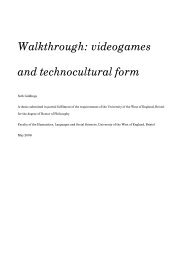“I'm the One Who Makes the Lego Racers Go ... - Seth Giddings
“I'm the One Who Makes the Lego Racers Go ... - Seth Giddings
“I'm the One Who Makes the Lego Racers Go ... - Seth Giddings
You also want an ePaper? Increase the reach of your titles
YUMPU automatically turns print PDFs into web optimized ePapers that Google loves.
What is going on when children incorporate videogames in <strong>the</strong>ir everyday<br />
domestic play? This chapter draws on detailed participant observations of my two sons<br />
playing at home with <strong>Lego</strong>: <strong>the</strong> bricks and <strong>the</strong> videogame. It explores and documents<br />
<strong>the</strong> ways in which videogame play can be continuous with, but also transformative of,<br />
children’s established toy and play culture. I begin by questioning <strong>the</strong> usually firm<br />
distinctions often made between virtual and actual space. Following that discussion, I<br />
describe a video recording of <strong>the</strong> two boys at play, tracking <strong>the</strong>ir movement between<br />
virtual and actual play realms. As <strong>the</strong> chapter progresses, what started out as a small‐<br />
scale improvised microethnography ends up raising unexpected but fundamental<br />
questions about children, play, and new technologies.<br />
The research on playing videogames tends to fall into one of two broad<br />
categories that indicate different approaches, foci, or conceptual frameworks:(i) some<br />
studies concentrate mainly on <strong>the</strong> social or communicative contexts and practices of<br />
new media, which frame and inflect playing (Alloway & Gilbert, 1998; Ito, 1998;<br />
McNamee, 1998; Wright, Boria, & Breidenbach, 2002) reflecting an ethnographic<br />
concern for describing and understanding observable, lived experience; (ii) o<strong>the</strong>r<br />
research tends to focus much more closely on <strong>the</strong> use of <strong>the</strong>ories of subjectivity to<br />
examine <strong>the</strong> complex nature of <strong>the</strong> relationships between humans and media<br />
(technological intimacy). Studies in <strong>the</strong> latter kind of research tend to echo cybercultural<br />
studies (or film <strong>the</strong>ory) in that <strong>the</strong>ir <strong>the</strong>orizations or cybertextual analyses are based on<br />
assumptions about <strong>the</strong> nature of interaction and immersion (<strong>the</strong> idea that users of <strong>the</strong><br />
internet or players of videogames are somehow present—or feel <strong>the</strong>mselves to be




